
It is believed that apricots came to us from China. It is not known for certain, but now apricots are popular both in Asia and in Europe.
These beautiful rounded odnokostianki yellowish-red color with a velvety skin and seeds similar to almonds, not only tasty, but also useful.
Apricot pulp contains inulin, fiber, sugars, starch, organic acids. There are vitamins C, PP, P, B1, B2 in the fruit. But most of all they are carotene - vitamin A. Also in the apricots are magnesium, potassium, phosphorus, iron, cobalt, copper, manganese.
Apricots are an excellent prophylactic agent for cardiovascular diseases. Dried apricots have a diuretic effect.
In these fruits a large amount of iron. They are recommended for people suffering from anemia and anemia, as they increase the level of hemoglobin in the blood.
Apricots must be included in the diet of people engaged in mental activity, because phosphorus and magnesium are useful for the active work of the brain.
Of course, apricots are better eaten raw, but in order to enjoy their taste in winter, the fruits are dried and canned: they cook compotes, jams, and jam.
There are many ways to make jam. It is boiled from whole fruits, cut in half, in slices. Prepare the jam and with the nucleoli, but this option is suitable only if the seeds (nucleoli) are sweet. Such a jam will be appreciated by even the most sophisticated gourmet.
Subtleties
- To make the jam quality, the fruits must be ripe, healthy and not wormy. Green apricots are not suitable for jam. Such a jam will be tasteless and non-flavored. Broken, wrinkled and over-ripe fruits are also not used, because they will fall apart. Of these, you can cook only jam and jam.
- Preserving the shape of the fruit depends on the method of cooking. It should be carried out in stages, so that the sugar penetrated into the fruit gradually. If you fill up the apricots with sugar and immediately boil them, then the sugar will quickly fill the intercellular space, the juice will go out into the syrup and the apricots will boil out, becoming a porridge.
- During cooking, jam cannot be mixed, otherwise the fruit will lose shape. The pelvis can only be shaken slightly.
- Foam, which will necessarily appear on the surface in large quantities, must be removed with a slotted spoon or a spoon.
- For finished products to look beautiful, apricots must be the same size.
- If jam is cooked from whole apricots, they are pre-punched in several places and blanched for five minutes at 80-90 °. Then quickly cooled.
- When cooking apricots with halves, they are first cut and the stone is carefully removed. Large apricots are divided into two halves and cut into slices.
- Jars for packaging of jam should be thoroughly washed, rinsed with boiling water and dried well in the sun or in the oven. You can not pour the jam in wet jars. Drops of moisture, getting into the jam, can cause the appearance of mold and its damage.
- If the jam is rolled up in tin lids, it is poured hot, filling the jars as completely as possible. Such jam is well kept in a regular room. The main thing is that the light does not fall on it and there are no heaters near it.
- But most often jam is packaged in banks in the already cooled form. Then it can be closed with ordinary parchment. This jam is stored in a dark cool place.
- For boiling jam with pits, varieties with sweet kernels are selected. The fact is that the bitter kernels contain amygdalin glycoside. If the jam is stored for a long time, this substance begins to produce poisonous hydrocyanic acid. Such a preparation may cause poisoning. Therefore, jam with stones or nucleoli store no more than one year.
Apricot jam with seeds: the first recipe
Ingredients for five 0, 5 l containers:
- apricots - 1 kg;
- sugar - 1, 5 kg;
- water - 400 ml;
- citric acid - 3 g.
Preparation Method
- Pick ripe fruit without wormholes. Remove the stalk. Wash well.
- Pour water into a large saucepan and bring to a boil. Dip the apricots in boiling water and blanch two minutes at 90 °. Then cool under running cold water. Wait for the fluid to drain. Then each fruit needs to be pricked with something sharp.
- Pour sugar into the cooking basin, pour water. Place on the stove and boil the syrup.
- Dip the apricots in the syrup, add citric acid and bring to a boil, removing the froth. Remove from heat.
- Leave the bowl of jam for 8 hours to cool.
- Then put the jam back on the stove and bring it to the boil again. Make sure that it does not burn: boil it over low heat. The second time, remove the jam from the stove and let it cool for eight hours.
- For the third time, put a bowl of jam on the stove and cook for some time. You can check the readiness by placing a drop of syrup on a saucer. She must keep the form. Also, the readiness of jam can be determined by the foam. By the end of cooking, the foam is collected in the center of the pelvis, and does not diverge around the edges.
- Cool the jam completely and place in jars. Cover with parchment paper, tie with twine or secure with rubber. Jam can be hermetically sealed. To do this, place it hot in dry jars, cover with lids and immediately roll up a special seamer. Cool it down.
Apricot jam with seeds: the second recipe
Ingredients for five 0, 5 l containers:
- apricots - 1 kg;
- sugar - 1, 25 kg;
- water - 2, 5 st.
Preparation Method
- Take only ripe apricots without wormholes for jam. Remove the stalk. Wash fruits.
- Pour water into a large saucepan, bring to a boil. Dip the apricots in it and blanch for five minutes at a temperature of 75-80 °.
- Quickly cool by immersing in cold water in a colander.
- Prick each fruit with something sharp.
- In a separate saucepan, boil a syrup of 800 g of sugar and water.
- In the bowl, fold all the apricots. Pour hot syrup. Hold for 4 hours.
- Put on the fire and boil for 5 minutes at a low boil, removing the foam that appears.
- Remove from the stove again and insist 10 hours.
- Add the remaining sugar, put on the fire and cook at low boil until cooked.
- Cool in the pelvis and then transfer to clean, dry jars. Close the parchment paper. If you want to roll the cans with tin lids, then pack the jam hot, filling the container as much as possible. Turn the sealed jars upside down and cool in this position.
Apricot jam slices, pitted
Ingredients for six 0, 5 l containers:
- apricots - 1 kg;
- sugar - 1, 5 kg;
- water - 500 ml;
- fruit essence - 10 drops;
- Vanillin to taste.
Preparation Method
- Wash ripe apricots, remove the stalk.
- Cut each fruit in half along the groove. Take out the bones.
- Pour sugar into a saucepan, pour water. Cook the syrup. If it turned out to be cloudy, strain through several layers of gauze.
- Apricots are folded in the cooking basin with the cut side up. Gently pour hot syrup. Leave for a day so that the fruits are soaked.
- The next day, pour the syrup into the saucepan and boil it. Again, pour them apricots. Leave for another day.
- On the third day, put a bowl of apricots on a small fire, bring to a boil and cook to the density you need. At the end of cooking, add the essence and vanillin diluted in a small amount of syrup.
- Remove from heat. Cool completely. Spread into clean and dry jars. Close the parchment paper.
Apricot jam “Five minutes”
Ingredients for five 0, 5 l containers:
- apricots - 1 kg;
- sugar - 1, 5 kg;
- water - 400 ml.
Preparation Method
- Ripe, not damaged by insects and diseases, wash the apricots, remove the stalks. Cut in half. Take out the bones. If the fruits are large, cut them into slices.
- Fold the apricots with the centers up in the cooking basin, each layer is sprinkled with sugar. Leave for 6-8 hours (longer). During this time, the fruit will give the juice, which partially dissolve the sugar.
- After this time, pour water into the basin and place it on the stove. If you want to get a thick jam, you can not add water. Over medium heat bring to a boil. So that the jam does not acquire the consistency of jam, it is not stirred during cooking. You can only shake the pelvis a little or twist it from side to side. Boil 5 minutes, be sure to remove the foam.
- Then remove the pelvis from the stove and let the jam stand for 3-5 hours.
- Over low heat, bring to a boil again and boil again 5 minutes.
- After 5 hours of infusion, repeat this procedure again.
- Pour the hot jam into prepared clean and dried jars and immediately roll up the lids. Turn upside down and leave to cool in this position.
Apricot Preserves “Royal”
Ingredients for three 0, 5 l capacity:
- apricots - 1 kg;
- sugar - 400 g;
- water - 250 ml.
Preparation Method
- Ripe but strong apricots are suitable for this jam. Go through them, remove the stem. Then wash the fruit well and dry.
- From each apricot, make a small cut along the groove, squeeze out a stone.
- Break the bones in the way that suits you. Purify the kernels from the skins. To peel off easily, immerse them in boiling water and hold there for a few minutes. Although this stage can be skipped and use the kernel in an unpurified form.
- Start apricots in grains by inserting them into the slot instead of stones.
- Fold the apricots in the cooking basin.
- Put sugar in a saucepan, pour water. Cook the syrup. Fill them with fruit, bring to a boil and remove from heat. Leave for 10 hours to insist.
- Then put on a small fire again, bring to a boil, boil for 10-15 minutes on low heat, not forgetting to remove the foam.
- Remove the pelvis from the stove and once again leave for 10 hours to infuse.
- Last time, bring to a boil and cook for 10 minutes.
- When hot, place the apricot jam in clean, dry jars. Hermetically cork tin lids. If you plan to close the cans with parchment paper, then the jam should be completely cooled in the pelvis and only then filled.
Mistress to note
If you are afraid that the nucleoli in the jam may harm your health, you can safely replace them with something else: almond, walnut or hazelnut.
In the apricot jam, you can add cinnamon, lemon zest, cloves and other spices to taste. But they should not be many, so as not to drown out the natural apricot flavor.











































